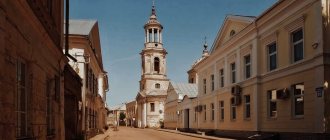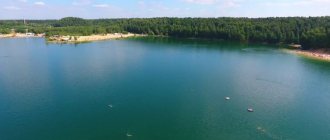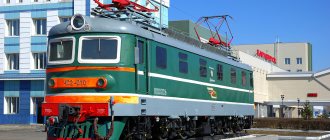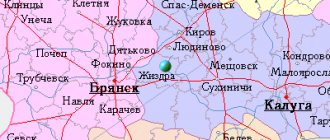Russian city
City in Kaluga region, Russia
| Sukhinichi Sukhinichi | |
| City [1] | |
| Sukhinichi intersection with coat of arms | |
| Flag Coat of arms | |
| Location of Sukhinichi | |
| Sukhinichi Location of Sukhinichi Show map of Russia Sukhinichi Sukhinichi (Kaluga region) Show map of Kaluga region | |
| Coordinates: 54°06'N 35°21'E / 54.100°N W. 35.350° E. / 54,100; 35.350 Coordinates: 54°06'N 35°21'E. / 54.100°N W. 35.350° E. / 54,100; 35,350 | |
| A country | Russia |
| Federal subject | Kaluga region [1] |
| Administrative region | Sukhinichi district [1] |
| Based | first half of the 16th century [2] |
| City status from | 1840 » [2] |
| Height | 200 m (700 ft) |
| population size (2010 Census) [3] | |
| • General | 16 273 |
| • Evaluate (2018) [4] | 14 901 ( -8,4% ) |
| Administrative status | |
| • Capital from | Sukhinichi district [1] |
| Municipal status | |
| • Municipal district | Sukhinichi municipal district [5] |
| • Urban village | Urban settlement Sukhinichi [5] |
| • Capital from | Sukhinichi municipal district [5], urban settlement Sukhinichi [5] |
| Timezone | UTC+3 (MSK[6]) |
| Postal code [7] | 249270, 249271, 249273–249275 |
| OKTMO ID | 29636101001 |
| Web site | info-suhinichi.ru |
Sukhinichi
(Russian: Sukhinichi) is a city and the administrative center of Sukhinichi District in Kaluga Oblast, Russia, a major railway junction on the Moscow–Kyiv line, located on the Brin River 105 kilometers (65 mi) southwest of Kaluga, the administrative center of the region. Population: 16,273 (2010 census); [3] 16,387 (2002 census); [8] 17,762 (1989 census). [9]
Links[edit]
Notes[edit]
- ^ abcde State Committee of the Russian Federation on Statistics. Committee of the Russian Federation for Standardization, Metrology and Certification. No. OK 019-95 January 1, 1997 “All-Russian classifier of objects of administrative-territorial division. Code 29 236", ed. changes No. 278 / 2015 dated January 1, 2016. (Goskomstat of the Russian Federation. Committee of the Russian Federation for Standardization, Metrology and Certification. No. OK 019-95 January 1, 1997. Russian classification of administrative divisions) (OKATO).
Code 29 236 , as amended by Amendment No. 278/2015 of 01/01/2016). - ^ B s d "General information" (in Russian). Retrieved January 5, 2022.
- ^ a b Federal State Statistics Service (2011). “All-Russian Population Census 2010. Volume 1" [All-Russian Population Census 2010, vol. 1]. All-Russian Population Census 2010 [All-Russian Population Census 2010]
. Federal State Statistics Service. - "26. The size of the permanent population of the Russian Federation by municipalities as of January 1, 2022". Federal State Statistics Service. Retrieved January 23, 2022.
- ^ abcde Law No. 369-OZ
- "On the Calculation of Time". Official Internet portal of legal information
. June 3, 2011. Retrieved January 19, 2022. - Post office. Information and computing center of OASU RPO. ( Post office
).
Search for postal service objects ( postal Search for objects
) (in Russian) - ↑
Federal State Statistics Service of Russia (May 21, 2004).
“The population of Russia, the constituent entities of the Russian Federation as part of federal districts, urban settlements, settlements, settlements of 3 thousand or more people” [Population of Russia, its federal districts, federal districts, districts, urban settlements, rural settlements - administrative centers and rural settlements with a population of more than 3,000 people] (XLS). All-Russian Population Census 2002
. - “All-Union Population Census of 1989. The current population of union and autonomous republics, autonomous regions and districts, territories, effects, urban settlements and rural district centers” [All-Union Population Census of 1989: current population of union and autonomous republics, Autonomous regions and districts, territories, regions, districts, urban settlements and villages performing the functions of district administrative centers. All-Union Population Census of 1989 [All-Union Population Census of 1989]
.
Institute of Demography of the National Research University: Higher School of Economics [Institute of Demography of the National Research University: Higher School of Economics]. 1989 - via Demoscope Weekly
. - “In Sukhinichi, the temple in honor of the Smolensk Icon of the Mother of God is being prepared for the 250th anniversary.” nikatv.ru
. July 21, 2022. Retrieved September 26, 2022. - "Sukhinichi district". Retrieved September 16, 2022.
- “Administration of the urban settlement” City of Sukhinichi » » . Retrieved September 26, 2022.
Sources [edit]
- Legislative Assembly of the Kaluga Region. Law No. 369-OZ of November 1, 2004 “On establishing the boundaries of municipalities, the territory of administrative-territorial units “Duminichsky district”, “Kirovsky district”, “Medynsky district”, “Peremyshlsky district”, “Sukhinichisky district”, “Tarussky” district", "Yukhnovsky district", and granting them the status of an urban settlement, rural settlement, municipal district", as ed. Law No. 728-OZ of May 29, 2015 “On Amendments to the Law of the Kaluga Region” On establishing the boundaries of municipalities, territories on the territory of the administrative-territorial units “Duminichsky District”, “Kirovsky District”, “Medynsky District”, “Peremyshlsky” district", "Underground district"., "Tarussky district", "Yukhnovsky district", and giving them the status of an urban settlement, rural settlement, municipal district." Duminichsky district, Kirovsky district, Medynsky district, Peremyshlsky district, Sukhinichsky district, Tarussky district, Yukhnovsky district of the Kaluga region, but not earlier than ten days after its official publication. Published: “Vest”, No. 336–338, November 10, 2004. Came into force after the Law of the Kaluga Region “On changing settlements on the territory of the administrative-territorial units “Duminichsky District”, “Kirovsky District”, “Medynsky District” came into force "," Peremyshlsky district "," Sukhinichi district "," Tarussky district "," Yukhnovsky district " Kaluga region", but not earlier than ten days after its official publication. Published: “Vest”, No. 336–338, November 10, 2004. Came into force after the Law of the Kaluga Region “On changing settlements on the territory of the administrative-territorial units “Duminichsky District”, “Kirovsky District”, “Medynsky District” came into force "," Peremyshlsky district "," Sukhinichi district "," Tarussky district "," Yukhnovsky district " Kaluga region", but not earlier than ten days after its official publication. Published: “Vest”, No. 336–338, November 10, 2004 Sukhinichi district “,” Tarusa district “,” Yukhnovsky district “Kaluga region”, but not earlier than ten days after its official publication. Published: “Vest”, No. 336–338, November 10, 2004 Sukhinichi district “,” Tarussky district “,” Yukhnovsky district “Kaluga region”, but not earlier than ten days after its official publication. Published: “Vest”, No. 336–338, November 10, 2004 (Legislative Assembly of the Kaluga Region. Law of November 1, 2004 No. 369-OZ “ On establishing the boundaries of municipalities located on the territory of administrative-territorial units” of the Duminichsky district , “Kirovsky district”, “Medynsky district”, “Peremyshlsky district”, “Sukhinichi district”, “Tarussky district”, “Yukhnovsky district” and on assigning them the status of an urban settlement, rural settlement, municipal district as
amended by Law No. 728-OZ dated May 29, 2015
On amendments to the Law of the Kaluga Region “On establishing the boundaries of municipalities located on the territory of the administrative-territorial units “Duminichsky District”, “Kirovsky District”, “Medynsky District”, “Peremyshlsky District”, “ Sukhinichi district "", "Tarussky district", "Yukhnovsky district" and on assigning them the status of an urban settlement, rural settlement, municipal district"
. Comes into force after the Law of the Kaluga Region "On changing the status of settlements located on the territory of administrative-territorial units “Duminichsky district”, “Kirovsky district”, “Medynsky district”, “Peremyshlsky district”, Sukhinichsky district”, “Tarussky district”, “Yukhnovsky district” of the Kaluga region”, but not earlier than ten days after the official publication.) .
Cities
Sukhinichi city
- a city in Russia, the administrative center of the Sukhinichi district of the Kaluga region. A junction of railway lines (to Bryansk, Moscow, Roslavl, Tula), two large railway stations - Sukhinichi-Glavnye and Sukhinichi-Uzlovye. Located in the Kaluga region, on the left bank of the Bryn River, 5 km from the M3 Moscow-Kyiv highway, 105 km southwest of Kaluga. With the construction of the Moscow-Kursk, Moscow-Brest and Syzran-Vyazemskaya railways, Sukhinichi became an important railway junction, a center for trading hemp oil, etc.
OKATO code: 29236501 Founded: 1st half. 18th century City since: 1840 Deviation from Moscow time, hours: 0 Geographic latitude: 54°06′ Geographic longitude: 35°21′ Altitude above sea level, meters: 200
Education in the city of
Sukhinichi
On the territory of the city there are 5 urban schools (Schools No. 1,2,3,4,12) and a large number of rural and village schools: Seredeyskaya secondary school, Shlipovskaya secondary school, Alnerskaya, Dabuzhskaya, Glazovskaya, Khotenskaya. In addition, in the city of Sukhinichi there is a professional lyceum - PL-17 (now the State Educational Institution “College of Transport and Service”), where you can receive secondary vocational education.
Economy of the city of
Sukhinichi
Furniture production Garment industry Plastic products factory Railway transport enterprises There is a drying and dairy plant
History of the city of
Sukhinichi
This city was founded at the end of the 18th century, but was never an administrative center, never had the status of a county town and is one of those very few Russian cities that built themselves, thanks to the development of economic life, and were not built for the military or administrative needs.
Even before it became a city (1840), the village of Sukhinichi served as an important transshipment point for goods such as lard, hemp, hemp oil and others, heading through it to the piers of the Volga and Western Dvina. Trade was one of the characteristic features of this point at that time. In winter alone, from six to ten thousand loaded carts passed through it annually, and the turnover of this trade was no less than 25 million rubles. As a rule, the goods were sent to the Zubtsovskaya and Rzhevskaya piers, and from there to the Riga and St. Petersburg ports.
Active economic development in the region began in the late 18th and early 19th centuries, when the city of Sukhinichi began to acquire important commercial importance. During this period, all the main surviving monuments of architecture and urban planning were built. Famous archaeological monuments date back to the first half of the first millennium of the new era - these are mounds, fortifications, and settlements.
After two railways were built through Sukhinichi (the Moscow-Bryansk branch of the Moscow-Kievo-Voronezh branch and the Dankov-Smolensk branch of the Ryazan-Uralskaya), the city’s prosperity, trade and industry received an additional impetus for development. Thus, being connected with nearby and more distant settlements, this town attracted more and more people to live there, although it did not have county status. Even in the first years after the October Revolution in Sukhinichi, as a rule, there were large bazaars on Saturdays and Sundays, and fairs twice a year, which were popular not only among nearby, but also quite remote settlements.
The means of delivering food and various products were, of course, carts of various designs, and on market days throughout the middle part of the town there were shafts pointing upward from carts bringing various goods for sale.
The events of 1917 made significant adjustments to the development of not only the city of Sukhinichi, but also the entire country. In the 20-30s. changes occurred in all areas of activity, culture and religion of the city residents.
In 1927, the city became the center of the newly formed Sukhinichi district of the Kaluga province.
In 1929, the city became the center of the Sukhinichi district and the Sukhinichi district of the Western region.
In 1930, the Sukhinichi district was abolished, in 1937 - the Western region, the city became part of the Smolensk region.
During the Great Patriotic War it was occupied from October 7, 1941 to January 29, 1942. Every year on January 29th the City Liberation Day is celebrated.
Since 1944, the city has been part of the Kaluga region.
On December 23, 2006, a monument to K.K. Rokossovsky, who commanded the 16th Army that liberated the city, was erected in Sukhinichi.
| Coat of arms of the city of Sukhinichi - Historical coat of arms of the city of Sukhinichi: “The shield is divided into two parts: in the top there is the coat of arms of Kaluga, and in the bottom, in a blue field there is a field of trading scales and under them two barrels.” | The flag of the city of Sukhinichi has not yet been approved and is therefore missing |
The city of Sukhinichi is the administrative center of the Municipal District " Sukhinichi District ". Located 250 kilometers southwest of Moscow, in a picturesque area of the Kaluga region. It is a major railway junction of the Moscow Railway of JSC Russian Railways with five directions of train traffic: to Moscow, Ukraine, Belarus, Moldova, Smolensk, Tula and through them to European countries and southern Russia. M3 highway crosses the area in a southwestern direction at a distance of 5 km from the city of Sukhinichi .
The area of the city is 2.232 thousand hectares. 16,232 people live in the city.
At the beginning of the 15th century, the Grand Duke of Lithuania Vitovt, who conquered the Smolensk principality, included Sukhinichi among the volosts that he gave to the Meshchov princes who came into his service.
Although the official date of birth of the Sukhinichi is considered to be 1840.
In 1552, Tsar Fyodor donated the free village of Sukhinichi to the Ascension Nunnery, which was located in the Moscow Kremlin.
After the liquidation of the monastic possessions in 1764, it was assigned to the Moscow Economic Collegium and received the name economic, free from serfdom.
When the military and merchant fleet began to rapidly develop in the 18th century, manufactories for the production of sailing cloth appeared in many places in central Russia. By the second half of the 18th century, Sukhinichi turned into a large trading center, serving as a warehouse point not only for the merchants of the Kaluga province, but also for others trading with foreign countries. In winter, up to 6 thousand carts with grain goods passed through Sukhinichi to the ports of Riga and St. Petersburg. Visiting merchants from Moscow, Kaluga, Tula, Bryansk, Rzhev opened their own offices, built stone warehouses, and began trading. In the center of the village there was a large trading area, where numerous shops were located in rows and around which stone buildings were built.
By the second half of the 18th century, Sukhinichi turned into a large trading center, serving as a warehouse point not only for the merchants of the Kaluga province, but also for others trading with foreign countries. In winter, up to 6 thousand carts with grain goods passed through Sukhinichi to the ports of Riga and St. Petersburg.
In the first half of the 19th century, a hemp market of all-Russian importance developed in Sukhinichi . The village becomes the most important transit point in trade between the southern and central parts of European Russia. It was precisely this circumstance that renamed the village into the city of Sukhinichi, which does not have a district under its subordination, which also included three neighboring villages - Khanchikovo, Trosna, Pernovichi.
On August 1, 1840, the city of Sukhinichi . The new city was established by the Decree of Tsar Nicholas not for the needs of administrative management, but for industrial purposes.
In 1860, there were 945 buildings in the city, of which only 5 were made of stone. 6148 people lived. The female population exceeded the male population by 236 people. In the city at that time there were 3 churches and 2 schools with three teachers.
In 1864, during the zemstvo reform, Sukhinichi became subordinate to the Kozelsky district. By the end of the 19th century, the center of the village began to look like a city: the main streets were landscaped. There were two cobblestone streets: the central one was called Bolkhovskaya (now Lenin) and the relatively short Cathedral Street (now Kravchenko Street). Yakovlevskaya Square was landscaped, a city hall building, a wooden hospital building (1896) and an apartment for doctors and medical staff were built; a bank opened in 1876 as an indication of growing trade. To improve service for trade operations, a telegraph station was opened in the summer of 1878. By 1880, with donations from parishioners, an almshouse named after Chubykin (the white building of school No. 1) was built for 30 people in need, that is, for the elderly. After the revolution, a second-level school was opened there.
The largest event in the history of the city was the railway construction that began at the end of the 19th century. In 1898-1904, two railways passed Sukhinichi With the construction of railway lines, the city of Sukhinichi lost its former importance as a large shopping center.
By 1912, the city's population increased to 7,000. There were 1,070 residential buildings, 64 streets.
In 1927, the city of Sukhinichi became the center of an enlarged district, which included the former Kozelsky and Meshchovsky.
In 1929, a new administrative division took place. The regions are divided into districts and districts. The Sukhinisky district of the western region included eleven districts (approximately within the current borders). A year later, the districts were abolished, and the Sukhinichesky district , like others, became directly subordinate to the regional city of Smolensk (and since 1944, Kaluga).
In the Uzlovye microdistrict, factories began operating: a brick factory, a vegetable drying plant, and a feed mill. In place of the mechanical stations (MTS), a production association grew up - "Selkhoztekhnika", working conditions improved - housing was built for the population, a club, a school, a kindergarten were built, new streets grew. In Soviet times, using the convenience of its geographical location, Sukhinichi became a city of large-scale industrial construction .
Today, the historical center of the city is the area from the Bryn River up Lenin Street, a spring on Baevka, a hippodrome towards the automobile plant, a hospital and an old cemetery.
By the beginning of the 19th century, there were two stone churches and one chapel Sukhinichi The first church built was a stone cathedral in the center of the village of Sukhinichi, consecrated in honor of Saints Athanasius and Cyril, archbishops of Alexandria. Its construction was completed in 1745. The main stone cathedral in honor of the Smolensk Icon of the Mother of God was built by the Tula merchant Khariton Pastukhov in 1770 next to the Church of St. Athanasius, which became his registered temple. The tall, 25-meter pillar-shaped bell tower of the Cathedral of the Smolensk Icon of the Mother of God was built at the expense of the townspeople. The square on which the churches stood was called Cathedral Square.
Telephone code: +7 48451 Official website of the city: www.info-suhinichi.ru




